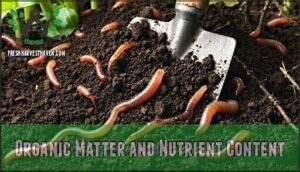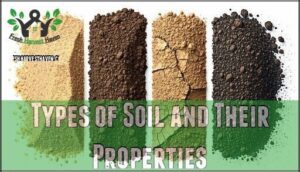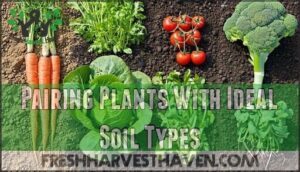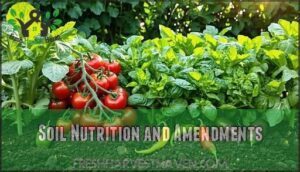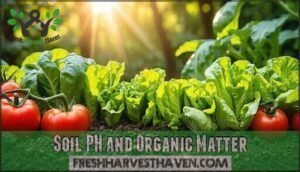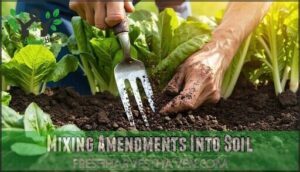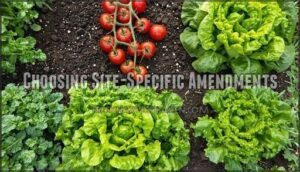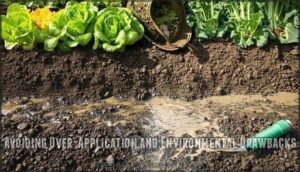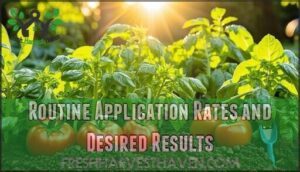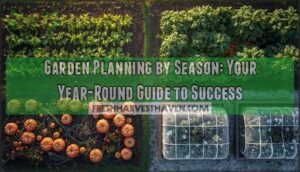This site is supported by our readers. We may earn a commission, at no cost to you, if you purchase through links.
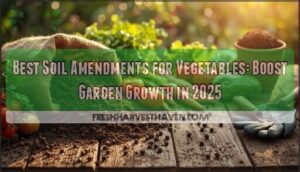
Mix in aged manure for a nutrient boost, and toss in leaf mold or peat moss if your soil’s feeling sandy or heavy.
These amendments improve drainage, feed roots, and help veggies soak up water like thirsty athletes.
Don’t forget to check your soil’s pH, since lime or sulfur can help keep things balanced.
Think of amendments as your garden’s support crew—they make the real stars (your veggies) shine.
Stick around, and you’ll uncover the secrets to pairing amendments with every vegetable in your patch.
Table Of Contents
- Key Takeaways
- Soil Preparation Basics
- Choosing Best Soil Amendments
- Soil Nutrition and Amendments
- Soil PH and Organic Matter
- Applying Soil Amendments Effectively
- Frequently Asked Questions (FAQs)
- What are the best soil additives for vegetables?
- How to amend soil for a vegetable garden?
- Which vegetables don’t like fertilizer?
- How to rejuvenate old soil for vegetables?
- What is the best soil combination for a vegetable garden?
- What should I add to soil for vegetables?
- How to amend soil for tomatoes and peppers?
- What is the PerFect amendment soil additive?
- How to improve soil drainage for vegetables?
- What precautions ensure safe use of manure amendments?
- Conclusion
Key Takeaways
- Mix compost and aged manure into your soil to boost nutrients, improve drainage, and support strong root growth.
- Test your soil’s pH before adding amendments like lime or sulfur, so your veggies can absorb nutrients efficiently.
- Pair amendments with your soil type—use leaf mold or peat moss for sandy soils and perlite or gypsum for heavy clay.
- Don’t overdo it; apply amendments gradually and check for signs of nutrient overload or pH imbalance to keep your garden healthy.
Soil Preparation Basics
Before you plant your first seed, you’ll need to prep your garden bed like you’re setting the stage for a great performance.
Start by clearing out rocks, weeds, and debris, then loosen that compacted soil so your vegetables’ roots can stretch out and thrive.
Give your veggies room to grow—clear the clutter and break up tough soil for thriving roots.
This will ensure your garden is ready for planting and that your vegetables have the best chance to grow and thrive.
Clearing Debris and Rocks
Three simple steps transform rough ground into vegetable-ready garden soil. Debris Identification starts your soil preparation—spot sticks, roots, and plant matter that’ll block growth. Rock Removal comes next; stones create barriers that stunt root development in your vegetable garden. Tool Selection matters too—use a rake for light debris, spade for stubborn rocks.
To effectively manage this process, consider investing in specialized removal equipment.
Here’s your clearing checklist:
- Survey and remove all visible debris, focusing on organic matter that could harbor pests
- Extract rocks larger than golf balls that’ll interfere with soil amendments and root expansion
- Sift remaining soil with a garden rake to catch smaller obstacles before planting
Smart Safe Disposal means composting organic debris separately from rocks—your future garden soil will thank you.
Loosening Soil for Root Development
Your clay soil doesn’t have to doom your vegetables to stunted growth.
Start by working that compacted earth when it’s slightly moist—not muddy or bone-dry. Drive a garden fork 8-12 inches deep, wiggling it back and forth to create air pockets for root penetration.
This compaction relief transforms dense clay soil into a breathable foundation. Better soil aeration means stronger root growth and improved drainage.
The deeper amendment depth you achieve now sets the stage for enhanced water retention and healthier soil structure throughout your growing season.
Leveling Garden Beds
After loosening your soil, grab a steel rake to level your garden beds—this essential step prevents water from pooling in low spots or rushing off high areas.
Slope considerations matter here; aim for gentle grades that guide water naturally without creating erosion problems.
Use measuring techniques like string lines to check evenness across larger beds. The right equipment needed includes a quality rake and possibly a garden hoe for stubborn clumps.
Proper leveling improves soil structure and drainage while supporting better soil aeration throughout your vegetable garden.
Considering Raised Beds
Building raised beds transforms vegetable growing by creating ideal drainage solutions and controlled soil environments.
These elevated systems let you craft perfect amendment layering while avoiding compacted ground issues.
A good soil mix includes quality compost for healthy root development.
Benefits include:
- Enhanced drainage: Prevents waterlogged roots in heavy clay
- Improved soil volume: More space for organic matter incorporation
- Better accessibility: Easier planting, weeding, and harvesting
- Custom bed material: Choose ideal retaining wall options for your space
Choosing Best Soil Amendments
You’ll want to match the right amendments to your soil type and vegetable needs for the best results.
Understanding your soil’s current state helps you choose between organic options like compost and manure, or mineral amendments like lime and greensand.
Organic Matter and Nutrient Content
Once you’ve prepared your garden beds, organic matter becomes your soil’s best friend.
Compost delivers slow-release nutrients while boosting microbial activity and water retention.
Amendment blends combining aged manure with leaf mold create powerhouse nutrient cycling systems.
This organic matter transforms poor soil into fertile ground, dramatically improving nutrient availability for your vegetables.
Smart soil fertility management starts here, setting the foundation for thriving vegetable growing seasons ahead.
Types of Soil and Their Properties
Since soil texture determines your garden’s success, knowing your soil type helps you choose the right soil amendments.
Sandy soil drains quickly but lacks nutrient availability.
Clay soil retains water yet becomes compacted, limiting root growth.
Loamy soil balances drainage with water retention, supporting ideal soil health.
Peat soil holds moisture but creates acidic conditions affecting soil pH and soil organisms essential for vegetable cultivation.
Pairing Plants With Ideal Soil Types
Beyond just throwing compost on your garden, plant-soil compatibility creates the foundation for vegetable cultivation success. Smart gardeners match their crops to ideal soil conditions rather than fighting against nature.
Understanding vegetable soil preferences helps you customize soil amendments effectively. Different vegetables thrive in specific soil types, and soil testing reveals what you’re working with:
- Sandy soils support carrots, radishes, and potatoes with excellent drainage and easy root penetration
- Clay soils benefit cabbage, broccoli, and Brussels sprouts through steady soil nutrients and moisture retention
- Loamy soils provide ideal growth media for tomatoes, peppers, and most vegetables with balanced drainage
- Silty soils suit spinach, celery, and leeks with good moisture retention and loose structure
Soil-specific vegetables perform better when you match their needs to your soil pH and existing conditions. To improve soil structure, consider how compost breaks down clay.
Soil Nutrition and Amendments
You want your vegetables to grow strong, so giving them the right nutrients and amendments is key.
If your soil’s missing something, don’t worry—there’s an amendment for every garden hiccup, even the ones your neighbor swears only happen to them.
Primary Nutrients for Plant Growth
Ever wondered why your veggies look tired? It’s all about soil nutrients—especially nitrogen, phosphorus, and potassium.
Tired veggies? They’re begging for a nutrient boost—nitrogen, phosphorus, and potassium are their secret to thriving.
Think of nitrogen as the leafy cheerleader, phosphorus as the root coach, and potassium as the plant’s bodyguard. Spotting nutrient deficiencies is easy: yellow leaves mean low nitrogen, stunted growth hints at missing phosphorus, and brown edges scream for potassium.
To improve your soil, consider that organic options aid in nutrient cycling. Check out this quick guide:
Secondary Nutrients for Plant Development
When chasing lush veggies, don’t overlook secondary nutrients—they’re the unsung heroes behind strong roots and vibrant leaves.
Calcium Deficiency can sneak up and stunt growth, while Magnesium Uptake keeps photosynthesis humming. Sulfur Importance? It’s your plant’s secret weapon for enzyme action and defense.
Want to nail Micronutrient Synergy and nutrient uptake? Try this:
- Add dolomitic lime for magnesium boost.
- Sprinkle gypsum or limestone to tackle calcium.
- Use elemental sulfur wisely—Amendment Timing matters!
Remember, phosphorus, potassium, and trace minerals also play supporting roles.
Applying Organic and Inorganic Amendments
Ready to give your veggies a leg up? After sorting out nutrients, let’s talk about amending soil with organic gardening and inorganic amendments.
Timing matters—add compost or manure in fall or spring for the best boost. Mix amendments into the top 6–8 inches, and watch out for salt buildup from inorganic amendments.
Ethical considerations count, so skip peat moss and bat guano. Try combining amendments for balanced results, but avoid overuse.
Here’s a quick cheat sheet for picking and applying soil amendments:
| Amendment Type | Example | Purpose | Longevity |
|---|---|---|---|
| Organic | Compost | Increases nutrients | Medium |
| Organic | Manure | Enhances fertility | Short |
| Inorganic | Perlite | Improves aeration | Long |
| Inorganic | Gypsum | Detoxifies soil | Medium |
Soil PH and Organic Matter
You can’t grow healthy vegetables if your soil’s pH is off or it’s missing organic matter, no matter how much you talk to your tomatoes.
Get these basics right, and your garden will reward you with strong plants and fewer headaches—plus, you won’t need a chemistry degree to make it happen, which is a significant advantage for gardeners without extensive chemistry knowledge.
Ideal PH Range for Vegetable Gardens
In the context of vegetable pH needs, most veggies love a pH balance between 6.0 and 7.0.
pH testing is your best friend—think of it as checking the soil’s “mood.”
Nutrient availability peaks here, so your plants won’t go hungry, and always factor in amendment effects and regional variations.
Some crops, like potatoes, prefer acidic soil, while beans like it neutral.
Adjusting Soil PH With Lime or Sulfur
If your last pH test showed soil is too acidic or too alkaline, don’t sweat it.
Lime Application raises pH for sweet-loving veggies, while Sulfur Application drops it for acid fans.
Here’s your playbook:
- Do reliable pH Testing before adding amendments.
- Work lime or sulfur into moist soil for best results.
- Monitor pH balance—changes can take months, so patience pays off.
Consider soil amendment products for ideal results.
Amendment Timing is everything!
Adding Compost and Aged Manure
A little compost and aged manure go a long way in the vegetable garden.
The Compost Benefits are clear: better texture, more nutrients, and happier Soil Microbes.
Manure Nutrients—especially from aged manure or worm compost—boost growth without the risk of burning plants.
Time your Application Timing right: add these natural fertilizers in spring or fall.
Mix the right Amendment Ratios, since too much can tip the scales.
Remember, a balanced soil amendment benefits your veggies more than a heavy hand—think of it as seasoning, not stuffing!
To improve structure and fertility, consider how organic matter helps.
Incorporating Leaf Mold and Peat Moss
After boosting your soil with compost and aged manure, leaf mold steps up as a moisture hero.
Leaf mold benefits vegetable gardening by improving texture and fueling the decomposition process.
Mix it into the top 6-8 inches, but skip walnut leaves—they’re trouble.
Need acidity? Peat moss works, but peat moss alternatives like coco coir offer sustainable sourcing and smarter application techniques for soil improvement.
Applying Soil Amendments Effectively
You want your soil amendments to work as hard as you do, so it’s important to mix them in properly and use the right amount for your garden.
Skip the guesswork—following a few simple steps will keep your veggies happy and your soil in top shape, without turning your backyard into a science experiment gone wild.
This approach ensures that your efforts yield the best results, making your garden thrive with happy veggies.
Mixing Amendments Into Soil
After you’ve balanced your soil’s pH, it’s time to get your hands dirty with amendment mixing. For high-quality soil improvement, focus on Amendment Distribution and Mixing Techniques.
Use a garden fork to blend amendments into the top 6-12 inches—think of it as layering a cake, not digging a hole to China. Consider using a specialized garden tool for superior mixing.
Try these for better soil conditioning:
- Layering Amendments evenly
- Smart Tool Selection
- Checking Amendment Depth
- Gentle soil amendment application for vegetable gardening
Choosing Site-Specific Amendments
Smart gardeners know one size doesn’t fit all when choosing soil amendments for vegetable gardens. Your soil test reveals what’s missing—maybe organic matter needs compost, or clay requires gypsum to break up compaction.
Sandy soil type calls for water-retaining amendments like aged manure, while heavy clay benefits from perlite or coarse sand.
Local availability and budget constraints shape choices too. Specific vegetables have preferences: tomatoes love phosphorus-rich bone meal, while leafy greens thrive with nitrogen boosters.
Consider long-term impact—biochar lasts years, while quick-release fertilizers need frequent reapplication.
Test your soil pH first, then match amendments to your garden’s unique fingerprint.
Avoiding Over-Application and Environmental Drawbacks
Too much of a good thing can backfire spectacularly.
Amendment overapplication creates nutrient runoff, pH imbalance, and soil contaminants that harm both plants and waterways.
Here’s how to avoid these pitfalls:
- Test soil before adding amendments to prevent herbicide contamination
- Choose ethically sourced materials to address environmental concerns
- Apply amendments gradually to minimize long-term impacts
- Monitor for salt buildup that indicates soil amendment safety issues
- Select sustainable alternatives to reduce soil amendment environmental impact
Routine Application Rates and Desired Results
Getting soil amendments right requires a game plan, not guesswork.
Apply compost at 1-2 inches annually, well-rotted manure at 25-30 pounds per 100 square feet, and fertilizer following soil testing results.
Check plant performance for visual indicators like leaf color and growth rate.
Amendment frequency depends on targeted outcomes—nitrogen-hungry crops need more frequent applications.
Rate adjustments based on soil testing kits prevent over-application while maximizing soil amendments application effectiveness.
Frequently Asked Questions (FAQs)
What are the best soil additives for vegetables?
Think of your soil like a hungry crowd at a buffet—compost, manure, worm castings, and greensand are the main courses.
Mix these in, and your veggies will grow strong, happy, and ready for harvest!
How to amend soil for a vegetable garden?
Start by mixing compost or aged manure into the top six inches of soil.
Toss in some leaf mold or perlite for drainage.
Don’t forget gloves—nobody wants manure hands at dinner!
Amend in spring or fall.
Which vegetables don’t like fertilizer?
Root veggies like carrots and radishes don’t love fertilizer—too much can make them fork or grow weird.
Beans and peas fix their own nitrogen, so skip the extra boost.
Let them do their thing!
How to rejuvenate old soil for vegetables?
You can revive tired soil by mixing in compost, aged manure, and leaf mold.
Toss in some worm castings for good measure.
Don’t forget to aerate—old soil loves a gust of cool air, too!
What is the best soil combination for a vegetable garden?
Picture digging into crumbly, chocolate-cake soil—rich compost, aged manure, a sprinkle of sand, and leaf mold.
This mix boosts drainage, feeds roots, and keeps veggies happy.
Don’t forget a dash of humor: worms love it too!
What should I add to soil for vegetables?
Mix in compost for nutrients and texture, toss in aged manure for extra oomph, and sprinkle greensand for minerals.
If you’ve got clay, add sand.
Don’t forget leaf mold—your veggies will thank you with bigger yields!
How to amend soil for tomatoes and peppers?
Think of your soil like a pizza crust—tomatoes and peppers want it fluffy, rich, and balanced.
Add compost, aged manure, and a sprinkle of lime.
Don’t forget worm castings for extra nutrients—your veggies will thank you!
What is the PerFect amendment soil additive?
You’ll find PerFect amendment soil additive is designed to boost soil fertility, structure, and water retention.
It’s usually a blend of organic and mineral ingredients, making your veggies happier and your garden chores a bit easier, with complete concepts in mind.
How to improve soil drainage for vegetables?
You’ll want to add perlite, coarse sand, or compost to your garden beds.
These boost drainage fast—no more soggy roots.
Just work them into the top six inches, and your veggies will breathe easier, promise!
What precautions ensure safe use of manure amendments?
Picture manure as garden gold, but handle with care—always wear gloves, turn it in quickly, and never spread it on frozen ground.
Wait 120 days before harvesting veggies, unless you enjoy playing roulette with food safety!
Conclusion
Picture your garden as a sports team—without the best soil amendments for vegetables, your veggies are stuck on the bench.
With compost, aged manure, and a good pH game plan, you’ll watch those plants hustle for the win.
Don’t skip the basics like mixing amendments and checking your soil type.
You’ll avoid rookie mistakes and make your harvest shine, give your veggies the support crew they deserve, and you’ll be cheering for bumper crops all season!

